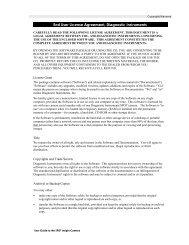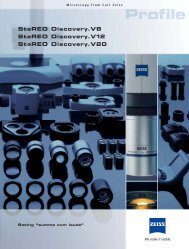optical interference filters - SPOT Imaging Solutions
optical interference filters - SPOT Imaging Solutions
optical interference filters - SPOT Imaging Solutions
Create successful ePaper yourself
Turn your PDF publications into a flip-book with our unique Google optimized e-Paper software.
choosing the optimal filter set<br />
Please consult our Fluorophore Reference Table (pages 105-107) for excitation and emission peaks, as well as for recommended filter<br />
sets, or visit curvomatic on our website.<br />
What is most important in your application – bright signal, dark background, color discrimination, or high signal-to-noise? While no<br />
single design can optimize for all dimensions, many designs provide a solution that gives good overall performance.<br />
• Does your application require customized reflection and transmission specifications for your dichroic?<br />
Call us for assistance.<br />
• Does your application require “imaging quality” <strong>filters</strong>? All 3 rd Millennium and QuantaMAX fluorescence <strong>filters</strong> in this catalog<br />
are suitable for imaging applications.<br />
What is your light source – halogen, laser, LED, mercury, xenon? Filters are designed to optimize performance for different light sources.<br />
Specify your detector – CCD, PMT, CMOS, film, eye. Filter blocking strategies are designed to optimize performance for different detectors.<br />
Zero Pixel Shift<br />
ZPS is recommended for multi-color applications and results in better discrimination. ZPS is also recommended for applications such as<br />
FISH (fluorescence in-situ hybridization), CGH (comparative genomic hybridization), SKY (spectral karyotyping), and co-localization studies.<br />
Please specify when ZPS is required. An additional charge may be added to the price of some sets.<br />
Figure of Merit - NEW Feature on Curvomatic<br />
Our new Figure of Merit calculator allows you to obtain the relative<br />
value of a single filter set effectiveness when combined with a light<br />
source and a single fluorophore to capture the spectral absorption<br />
and emission probability curves.<br />
When considering the merit of two or more filter sets independently,<br />
against the same fluorophore, the set with higher value will offer a<br />
greater ability to capture the fluorescence signal. The number returned<br />
by the Figure of Merit is a single benchmark by which to gauge if your<br />
filter set selection is best for a given application, or to compare two<br />
or more sets effectiveness against a particular fluorophore. It does<br />
not give a measure of the relative brightness that will be seen in the<br />
microscope as it does not consider the quantum yield or absorption<br />
coefficients of the selected fluorophore, the sample labeling density,<br />
or other experimental variables. Factors such as detector sensitivity<br />
at a given wavelength, the presence of other fluorophores, slight<br />
shifts in the absorption or emission peaks of the fluorophore, and the<br />
sample background all contribute to the overall system efficiency and<br />
are not considered here.<br />
Understanding the Results<br />
A few examples of returned results can help demonstrate how the<br />
Figure of Merit can help you decide which filter set is optimal in your<br />
set of conditions.<br />
Q: The results of filter set “X” and fluorophore “Y” = 0.<br />
Why the results are zero:<br />
A: The filter set is incompatible with the fluorophore or the light<br />
source (if selected).<br />
Check to make sure the fluorophores absorbance and emission<br />
profiles overlap the filter set's excitation and emission passbands.<br />
Verify that the excitation filter transmits the light source efficiently.<br />
Q: The results of filter set “X” and fluorophore “Y” is 425.<br />
Using the same fluorophore (“Y”) with a different filter set<br />
(“Z”) the result is 577. Is filter set “Z” the one I want?<br />
A: Figure of Merit is but one benchmark to use in making this decision.<br />
If filter set “Z” contains a long pass emission filter it will collect more<br />
signal (if the excitation filter is equivalent) than a bandpass filter and<br />
return a higher number, but it may also collect more background<br />
photons or signal from other fluorophores in the sample. If sample<br />
background and spectral bleed-through are not issues, then Set “Z”<br />
is the best choice.<br />
Q: I compared a narrow band filter (mFISH set XF202) to<br />
a wider band set (XF404 for Cy 2) and the returned values<br />
were 130.5 and 535.1 respectively. I am doing a multicolor<br />
assay and am worried about spectral bleed-through. Is<br />
the value too low for this set to be useful?<br />
A: No. A number that comes in several fold lower than another set,<br />
using the same fluorophore and light source, may indicate that in<br />
an ideal situation the higher value set will provide a much stronger<br />
signal, but it does not account for any noise factors. If you are doing<br />
a multicolor assay and do not efficiently reject bleed-through from<br />
other fluorophores, you may increase the total signal using the higher<br />
scoring filter set , but reduce the signal-to-noise because of the<br />
spectral bleed-through. You can actually use the tool to estimate the<br />
spectral bleed-through by placing another fluorophore on the graph<br />
and seeing the returned value of the two filter sets. In this case, if<br />
the other fluorophore was Cy3, the returned values for the XF202 and<br />
XF404 are 1.8 and 18.6 respectively.<br />
For current product listings, specifications, and pricing:<br />
www.omega<strong>filters</strong>.com • sales@omega<strong>filters</strong>.com<br />
1.866.488.1064 (toll free within USA only) • +1.802.254.2690 (outside USA)<br />
103

















